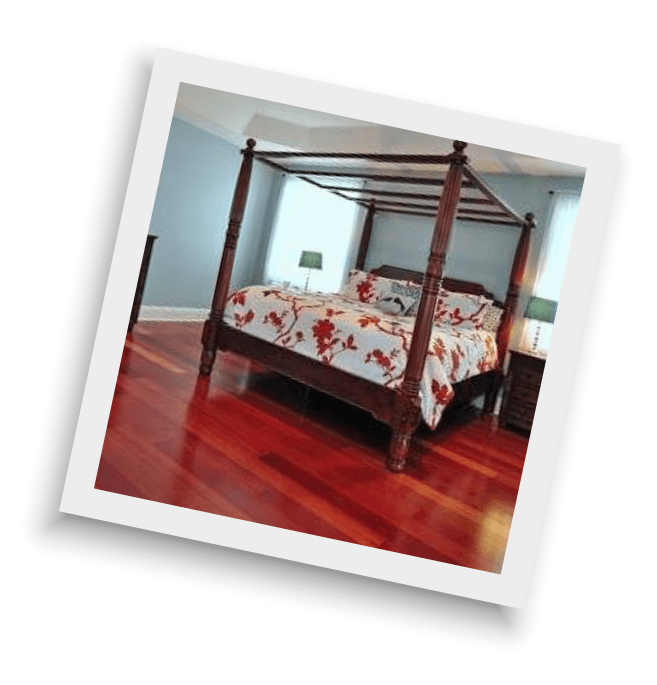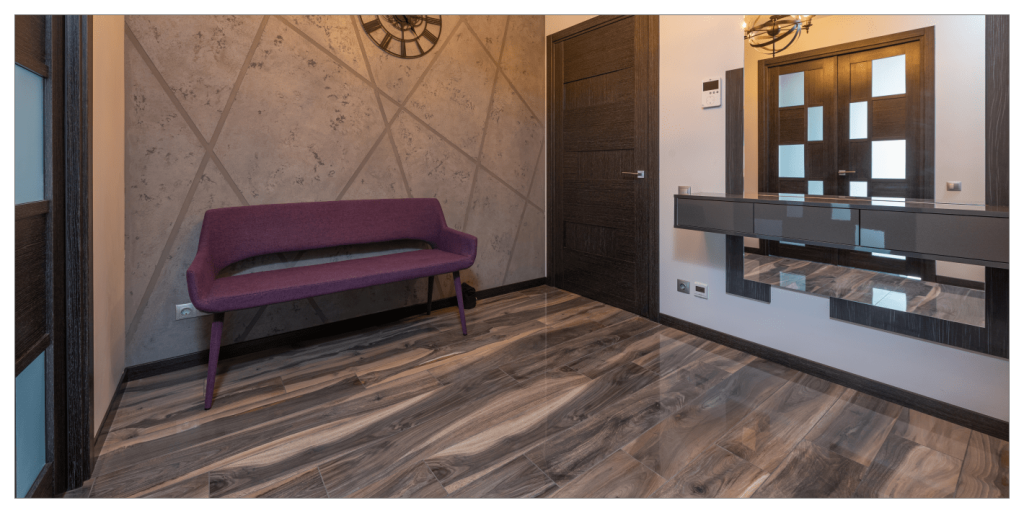What Is Laminate Flooring?
Laminate flooring is a type of flooring that looks like hardwood. It’s made with layers of paper or wood and comes in many different colors, styles, and textures. Laminate is fantastic for people who want a hardwood look without paying the high cost.
The most significant difference between natural wood floors and laminate is that laminate floors don’t expand or contract due to changes in temperature or humidity they’re much more stable than natural wood floors are.
They also don’t require special maintenance like cleaning oil spots from your floor which can be a major hassle for some people who own homes with traditional hardwood floors.

How are Laminate Floors Made?
The top layer is a tough, transparent wear layer. It’s available in many colors and patterns and can be used on its own or with other materials like carpeting or tile to create your custom look. The middle wear layer consists of high-density fiberboard (HDF), providing stability and dent resistance.
You’ll find this material on most laminate floors because it’s durable and easy to clean! The bottom layer is melamine backing that provides moisture resistance. It keeps your laminate floor from buckling when exposed to excess moisture, so you don’t have to worry about flooding or water damage ruining your floors!
Pros Of Laminate Floors
Durability
Laminate floors are durable enough to withstand lots of wear and tear, making them ideal for areas with frequent foot traffic, such as living rooms or kitchens. The durability also makes them an excellent choice for high-traffic areas such as hallways and foyers where carpet would be impractical due to its high installation costs.
The wood-like appearance also adds warmth to any room, making it a good choice for homes with children who may be prone to spilling drinks or food at meal times.
Cost-Effectiveness
The cost of installing laminate flooring is typically lower than other types of hardwood floors because it doesn't require expensive tools like saws or sanders to install correctly.
In addition, there's no need for special padding underneath laminate floors since they already have a cushioned layer between each plank, so they won't cause damage underneath your feet while walking around on top!
Numerous Designs and Colors
Laminate flooring comes in a wide range of colors and styles to suit any décor. With so many options available, it's easy to find something that will fit perfectly into your space without breaking the bank. In addition to the standard browns and tans most common in traditional hardwood installations, other popular shades include grayish blues, purples, vibrant reds, and oranges. If you're looking for a more natural look, there are even options available featuring wood grains similar to what you might find on traditional hardwood floors!
Moisture-Resistant
While it's true that you'll still want to wipe up spills as soon as they happen, this type of flooring won't warp or swell like natural wood will when exposed to water for too long. This means it's less likely to crack or break under pressure from heavy furniture or people walking on top of it all day long. It also means that installing laminate flooring in bathrooms or kitchens won't require major renovations or changes in how you use those rooms in your home!
Easy Maintenance
One of the most significant benefits of laminate flooring is its easy maintenance. Because it's a product of wood fibers bonded together with plastic resin, it doesn't require any special care or maintenance other than dusting off the surface every once in a while, with a damp cloth or sponge mop.
Pro: Laminate flooring is moisture-resistant. This makes it ideal for bathrooms, kitchens, and other rooms where moisture is likely to build up.
Cons Of Laminate Floors
Not as Warm as Hardwood
Laminate flooring is excellent for people who want the look of hardwood without dealing with all the maintenance that goes along with it. Unfortunately, laminate does not have the same natural warmth as real wood.
So, if you're looking for a cozy and warm atmosphere in your home, then laminate may not be the best choice.
Noise Reduction
One major drawback of laminate flooring is that it doesn't offer much sound insulation between rooms or between floors within an apartment building. It is especially so where each unit sits directly on top of each other without any walls separating them (like in a duplex).
If you're looking for a way to muffle the sound coming up through your floorboards, or want something that will keep your upstairs neighbor's footsteps from waking you up at night, then laminate might not be the best option.
Heat Retention
The second major drawback of laminate flooring is its tendency to trap heat inside your home during the hot summer months. If you live in a place where temperatures are consistently above 80 degrees Fahrenheit outside during the summer months, this material probably isn't suitable for your needs. The laminate flooring will exacerbate these issues over time and significantly increase energy usage costs by trapping all that heat indoors instead!
Vulnerable to Damage
Although the laminate flooring is durable, t is not immune to damage. It can be scratched, dented, and chipped easily. The biggest problem with laminate flooring is that it is not as strong as solid wood floors. If you have pets or small children in your home, you should consider another type of flooring. You may have to replace your laminate flooring more often than other types of flooring if you have kids or pets who like to run around on them all day long!
Laminate flooring has been a fixture in U.S. homes for decades now, and the reasons for its popularity are clear. It’s affordable, durable, and looks great. Laminate floors can be installed in a few hours, making them an easy way to update your home’s look without spending a fortune.


How to Maintain and Clean
Your Laminate Flooring
- Vacuum regularly with a soft brush attachment to remove dust and dirt from the surface of your laminate flooring.
- Mop with warm water and mild soap once a week or more if necessary.
- If spills happen on your laminate flooring, wipe up as much liquid as possible using paper towels, then use a damp
- After vacuuming or mopping, use a dry cloth or towel to wipe away any excess moisture from the surface of the laminated wood planks before letting them dry completely on their own (this will help prevent mold growth).
- Polish with a soft cloth dipped in mineral oil once every three months to improve shine and protect from scratches
- If you have pets or small children in your home, you may consider using a liquid pet-specific cleaner when cleaning your laminate floors. This will help remove stains caused by pet urine or other liquids that could otherwise cause damage to your floor's finish over time if left untreated!
What You Need to Know About
Laminate Flooring Prices
Laminate floors come in different quality levels, from very low-end to top-of-the-line. The cheapest laminates are often referred to as “core” or “economy,” while the most expensive ones bear names like “premium,” “elite,” and so forth. Higher quality means better performance and durability, but it also means that you’ll typically have to pay more for your flooring material.
You’ll pay quite a bit per square foot if you’re buying a small amount—less than 100 square feet for your laminate since there are no economies of scale involved in such small quantities.
However, when buying larger quantities (over 1,000 square feet), the price per square foot drops because there is far more demand for this product than there is supply available on store shelves at any given time.
Laminate flooring is one of the most affordable options available, but it can be challenging to decide which type of laminate flooring you should use. However, the type of installation you choose will affect the overall cost of your project.
There are different types of laminate floors you can choose from, including HPL Flooring (High-Pressure Laminate), DPL Flooring (Direct-Pressure Laminate), and LPL Flooring (Low-Pressure Laminate), etc. Each has its advantages and disadvantages, which will affect the overall cost of your project.
Laminate flooring is one of the most affordable options available, but it can be challenging to decide which type of laminate flooring you should use. However, the type of installation you choose will affect the overall cost of your project.
There are different types of laminate floors you can choose from, including HPL Flooring (High-Pressure Laminate), DPL Flooring (Direct-Pressure Laminate), and LPL Flooring (Low-Pressure Laminate), etc. Each has its advantages and disadvantages, which will affect the overall cost of your project.
Let Us Help You Redesign Your Home
Laminate flooring is an excellent choice for anyone looking to benefit from affordability, durability, and easy maintenance. It’s an excellent alternative to hardwood flooring, and you can install it on top of concrete or other surfaces that may not be ideal for natural wood.
Laminate is also easy to repair—you can replace individual planks or touch the surface with sandpaper or an electric sander when it shows signs of wear.
Call us today at 859-328-5772 for the best prices anywhere on laminate flooring. We are the best in the business, and we guarantee it! If you need a new look for your home or office, we can help. You can also visit our website to learn more about our products and services.

